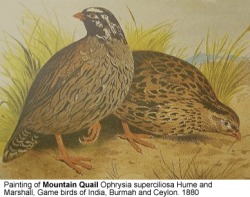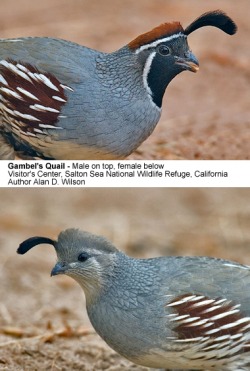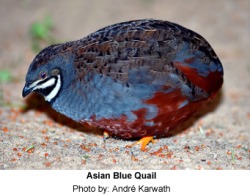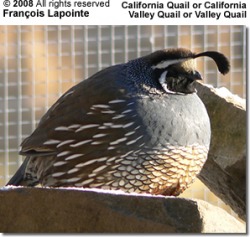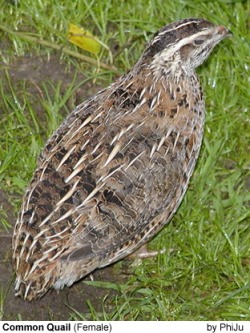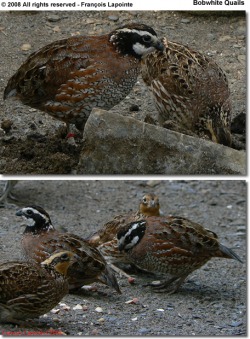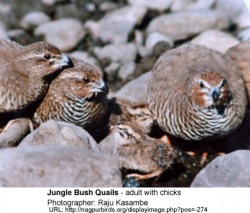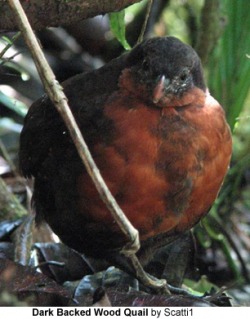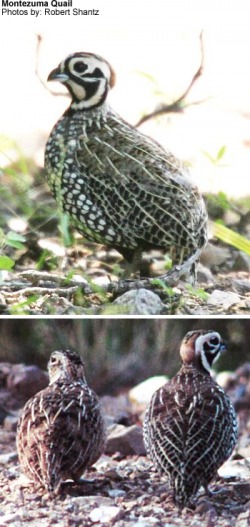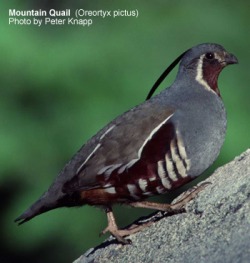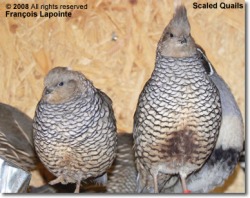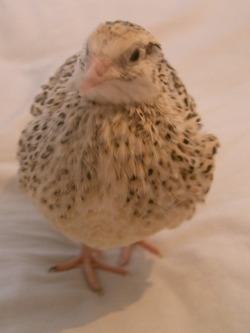Quail Species
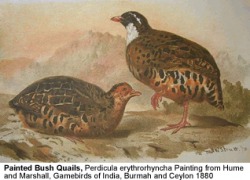
Quail is a collective name for several genera of mid-sized birds in the phesanst family Phasianidae, or in the family Odontophoridae. The below address the Old World species (Euope, Africa, Asia) . The The New World Quail(endemic to the Americas) are not closely related, but are named for their similar appearance and behaviour.
Please note that the Button Quail found in the Old World, are not true quails.
The quails are small, plump terrestrial birds. They are seed eaters, but will also take insects and similar small prey. They nest on the ground. They are capable of short, rapid bursts of flight. Some species, including the Japanese and Common Quail are migratory and fly for long distances.
Some quail are farmed in large numbers. These include Japanese Quail, also commonly known as coturnix quail, which are mostly kept to produce eggs that are sold worldwide.
Species in taxonomic order
Please note that the Button Quail found in the Old World, are not true quails.
The quails are small, plump terrestrial birds. They are seed eaters, but will also take insects and similar small prey. They nest on the ground. They are capable of short, rapid bursts of flight. Some species, including the Japanese and Common Quail are migratory and fly for long distances.
Some quail are farmed in large numbers. These include Japanese Quail, also commonly known as coturnix quail, which are mostly kept to produce eggs that are sold worldwide.
Species in taxonomic order
- Genus Coturnix
Common Quail, Coturnix coturnix
Description:
The Common Quail, Coturnix coturnix, is a small (17 cm) rotund bird, essentially streaked brown with a white eyestripe, and, in the male, a black chin. As befits its migratory nature, it has long wings, unlike most typically short-winged gamebirds.
Breeding / Range:
Upon attaining an age of 6-8 weeks, this quail breeds on open arable farmland and grassland across most of Europe and Asia, laying 6-18 eggs in a ground nest. The eggs take from 16-18 days to hatch. It is a strongly migratory bird, unlike most of the gamebirds, and winters in Africa.
Diet / Feeding:
This is a terrestrial species, feeding on seeds and insects on the ground. It is notoriously difficult to see, keeping hidden in crops, and reluctant to fly, preferring to creep away instead. Even when flushed, it keeps low and soon drops back into cover.
Song / Call:
Often the only indication of its presence is the distinctive "wet-my-lips" repetitive song of the male. The call is uttered mostly in the mornings, evenings and sometimes at night.
Status:
It is heavily hunted as game on passage through the Mediterranean area.
This species over recent years has seen an increase in its propagation in the United States and Europe, however most of this increase is with hobbyists.
- Japanese Quail, Coturnix japonica: Endemic to East Asia, abundant across most of its range. They migrate to Manchuria, southeastern Siberia, and northern Japan, and winter in southern Japan, the Korean Peninsula, and southern China. Their preferred habitats are grasslands and cultivated fields. The plumage is a speckled yellow-brown, with a creamy white strip above the eye. Adults are approximately 20 centimeters in length.
- Stubble Quail, Coturnix pectoralis: Resident of eastern, south-eastern and south-western Australia and Tasmania, where it is abundant. It inhabits agricultural areas, wet grasslands, coastal heaths, roadsides and neglected pastures.
- New Zealand Quail or Koreke (maori name), Coturnix novaezelandiae Extinct since 1875. The male and female were similar, except for the fact the female was lighter.
- Rain Quail, Coturnix coromandelica : They inhabit grassland, cropped fields and scrub in the Gangetic plains of central India and parts of peninsular India. They migrate further south in winter. They lack barring on the primaries (longest wing feathers). Male has a black breast-patch and distinctive head pattern of black and white. The female is difficult to separate from female Common Quail and Japanese Quail but the spots on the breast are more delicate. Call is a metallic chrink-chrink.
- Harlequin Quail, Coturnix delegorguei
- Brown Quail aka Swamp Quail, Coturnix ypsilophora : Their preferred habitat include agricultural areas, wet grasslands, shrublands and freshwater wetlands across much of New Guinea and the Lesser Sunda Islands as well as in northern, eastern, south-eastern and south-western Australia and Tasmania, though absent from arid regions. This species has been introduced to Fiji and New Zealand.They are widespread and common throughout its large range.
- Blue Quail, Coturnix adansonii
- Asian Blue Quail aka Chinese Painted Quail, King Quail or Blue-breasted Quail, Coturnix chinensis: This is the smallest of the true quails. They are endemic to southeastern Asia to Oceania. It is sometimes referred to as "Button Quail" - but button quails belong to the hemipode family, which is unrelated. These quails have become a favorite in aviculture, as they beautiful and hardy, and can become very trusting / tame. Additionally, numerous mutations have been developed. They are prolific breeders and reproduce at an incredible rate. A female will lay an egg a day if kept on the proper diet. They need only about a two foot long cage to breed successfully, but three times the space is needed for them to really thrive and to avoid fights.
- Japanese Quail, Coturnix japonica: Endemic to East Asia, abundant across most of its range. They migrate to Manchuria, southeastern Siberia, and northern Japan, and winter in southern Japan, the Korean Peninsula, and southern China. Their preferred habitats are grasslands and cultivated fields. The plumage is a speckled yellow-brown, with a creamy white strip above the eye. Adults are approximately 20 centimeters in length.
- Genus Anurophasis
- Snow Mountain Quail, Anurophasis monorthonyx : The Snow Mountain Quail is a large quail, approximately 11 inches (28 cm.) in length with a dark brown plumage, a horn-colored bill, yellow legs and brown irises. The underparts of the female are whitish and more heavily black barred than in the male. An Indonesian endemic, the Snow Mountain Quail is confined to New Guinea's highest elevations, the Snow Mountains of Irian Jaya - in the Alpine grasslands at an elevation above 9850 ft (3000 metres). The female lays up to three pale brown, dark-spotted eggs in a hollow nest under the edge of a grass tussock. The diet consists mainly of seeds, flowers, leaves and other vegetation matters. Due to its limited range and it being unprotected by Indonesian government, the Snow Mountain Quail is evaluated as Near Threatened.
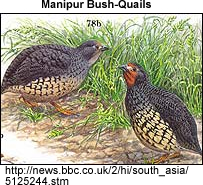
Genus Perdicula: Jungle Bush Quail. Perdicula asiatica
Genus Ophrysia
Himalayan : Ophrysia superciliosa Critically Endangered/Extinct
The Himalayan Quail, Ophrysia superciliosa is a medium-sized quail belong to the pheasant family. It was extremely rare and is feared extinct. This species is known with certainty only from 2 locations in the western Himalayas in Uttarakhand, north-west India. The last verifiable record was in 1876, despite a number of searches, but its continued survival cannot be ruled out as it may be difficult to detect. The most recent unconfirmed reports are of a number of possible sightings around Nainital in 2003.
Description
From Frank Finn's The Game Birds of India & Asia (1911):
The Mountain quail—so called, for it is the least quail-like of all these little birds—is rather larger than the common grey quail, with a decidedly long tail for a bird of the kind, this appendage being fully as long as or longer than any ordinary partridge's, although all but covered above and below by thelong tail-coverts. The general feathering is also of a long type, but the wings are decidedly short, and the colouring will at once distinguish the bird from any other of the family. The cock and hen, though neither is brilliantly coloured, are absolutely unlike each other, the former being slate-grey, tinged with olive above, and with black edgings to the sides of the feathers, a black, head streaked with white, and black under-tail-coverts spotted with white; while the latter is brown, spotted with black centres to the feathers and the face a sort of pinkish grey. Remnants of the young plumage on some specimens in the British Museum seem to show that both sexes when young have a garb of closely mottled black, brown and buff, so that they might easily be passed over as of no particular account if the comparatively large tail were not noticed. The bill is red, bright coral in the male and dusky in the female, and the legs are dull red. In a pair kept in England the bill and legs were yellow. The length is about ten inches, with the tail three, the wing being only three and-a-half, and the shank one. The mountain quail was described in 1846 by J. E. Gray from living specimens in the fine collection of the Earl of Derby at Knowsley Hall, and he gave the locality as " India" with a query. Nothing more was heard of it till 1865, when Kenneth Mackinnon shot a pair in November, in a hollow between Budraj and Benog, behind Mussoorie, at about 6,000 feet elevation. Again, in November, but two years later, at least one party established themselves at Jerepani, and remained till the summer of 1868; and five specimens were procured. Then, in December 1876, Major G. Carwithen got one bird on the eastern slopes of Sher-ka-danda, close to Naini Tal, at an elevation of 7,000 feet. No specimens have turned up since. It seems to be a migratory bird, arriving in winter, although its small wings look ill-adapted for a journey of any length. It goes in single pairs or coveys, and keeps close to cover in grass jungle or brushwood, being almost impossible to flush without a dog. Its flight is heavy, slow, and short; its food, grass seeds. The call is a shrill whistle. Anyone coming across these birds again should do his best to secure a living pair or two, and either breed from them himself— which could probably be done in the hills in a well-grassed run—or send them Home to the London Zoological Gardens or down to the Calcutta Gardens. In this way eggs might be obtained, whereas we are likely to wait a long time for them if we look to the discovery of a nest in the wild state in the case of such a rare and erratic bird as this one appears to be
- Rock Bush-quail, Perdicula argoondah
- Painted Bush-quail, Perdicula erythrorhyncha: is found in the hill forests of India. They move in small coveys on hillsides and are distinguished by their red bills and legs. They have a liquid alarm call and small groups will run in single file along paths before taking flight when flushed.
Manipur Bush Quail.Perdicula manipurensis
The Manipur Bush Quail (Perdicula manipurensis) is a species of quail found in India, inhabiting damp grassland, particularly stands of tall grass, in West Bengal, Assam, Nagaland, Manipur, and Meghalaya. It was collected and described by Allan Octavian Hume on an ornithological expedition to Manipur in 1881.
P. manipurensis is listed as Vulnerable in IUCN's Red List, as its habitat is small, fragmented, and rapidly shrinking. There was no confirmed sighting of the bird from 1932 until 2006, suggesting that it might have been in fact extinct. However, in June of the latter year, noted Indian birdwatcher and wildlife expert Anwaruddin Choudhury reported spotting the quail in Assam. While Choudhury was unable to photograph the bird, Indian wildlife authorities consider him a reliable witness. BBC News quoted the conservation director of the Wildlife Trust of India, Rahul Kaul, as saying, "This creature has almost literally returned from the dead."
The following description of the species by Frank Finn (1911) suggests that the species was earlier much commoner.
Native name: Lanx-Soibol, Manipuri.
One of Mr. Hume's most striking discoveries in Manipur, this pretty quail is very distinct in appearance from all our species. Its plumage is slate-colour, mottled with black above, and buff below the breast, this colour broken up into large spots by black markings which form a cross on every feather. The cock has a dark bay face, which at once distinguishes him from the hen. The bill is dark horny, and the legs orange.
In length this species is about seven inches, with a wing a little over three, and a tail of two inches.
Mr. Hume discovered this species himself when in Manipur, and obtained nine specimens (all he saw except two which were lost) after immense labour and two days' beating in an expanse of elephant grass covering broken ground about two miles square. The birds were in two coveys, and those shot were found to have fed upon both seeds and insects A single bird was shot ten days later in the same district, and there is a specimen in the British Museum said to be from Sikkim. But except for these few specimens, nothing more was known of the Manipur bush-quail till 1899, nearly twenty years after Mr. Hume's discovery of the bird, when Captain H. S. Wood, of the Indian Medical Service, presented one to the Indian museum, and Lieutenant H. H. Turner two others. Captain Wood, who had found the species quite common in Manipur, afterwards wrote an interesting note on it in the Asiatic Society's Journal for 1899. He had shot about eighty of these quail, and did not consider them at all uncommon. The native name means "Trap Quail" as the Nagas snare numbers of them in nooses after jungle fires. The birds breed in Manipur, and the egg is large in proportion to the size of the bird, and greenish in colour with black and brown patches; unfortunately Captain Wood's specimens of them got broken in transit. He found the birds hard to see except after the jungle fires from February to April as they kept to dense cover, and even after a fire their dark colour made them hard to see on the burnt grass they were always found close to water. The coveys kept very close when running, and Captain Wood has bagged as many as four at a shot.
Himalayan : Ophrysia superciliosa Critically Endangered/Extinct
The Himalayan Quail, Ophrysia superciliosa is a medium-sized quail belong to the pheasant family. It was extremely rare and is feared extinct. This species is known with certainty only from 2 locations in the western Himalayas in Uttarakhand, north-west India. The last verifiable record was in 1876, despite a number of searches, but its continued survival cannot be ruled out as it may be difficult to detect. The most recent unconfirmed reports are of a number of possible sightings around Nainital in 2003.
Description
From Frank Finn's The Game Birds of India & Asia (1911):
The Mountain quail—so called, for it is the least quail-like of all these little birds—is rather larger than the common grey quail, with a decidedly long tail for a bird of the kind, this appendage being fully as long as or longer than any ordinary partridge's, although all but covered above and below by thelong tail-coverts. The general feathering is also of a long type, but the wings are decidedly short, and the colouring will at once distinguish the bird from any other of the family. The cock and hen, though neither is brilliantly coloured, are absolutely unlike each other, the former being slate-grey, tinged with olive above, and with black edgings to the sides of the feathers, a black, head streaked with white, and black under-tail-coverts spotted with white; while the latter is brown, spotted with black centres to the feathers and the face a sort of pinkish grey. Remnants of the young plumage on some specimens in the British Museum seem to show that both sexes when young have a garb of closely mottled black, brown and buff, so that they might easily be passed over as of no particular account if the comparatively large tail were not noticed. The bill is red, bright coral in the male and dusky in the female, and the legs are dull red. In a pair kept in England the bill and legs were yellow. The length is about ten inches, with the tail three, the wing being only three and-a-half, and the shank one. The mountain quail was described in 1846 by J. E. Gray from living specimens in the fine collection of the Earl of Derby at Knowsley Hall, and he gave the locality as " India" with a query. Nothing more was heard of it till 1865, when Kenneth Mackinnon shot a pair in November, in a hollow between Budraj and Benog, behind Mussoorie, at about 6,000 feet elevation. Again, in November, but two years later, at least one party established themselves at Jerepani, and remained till the summer of 1868; and five specimens were procured. Then, in December 1876, Major G. Carwithen got one bird on the eastern slopes of Sher-ka-danda, close to Naini Tal, at an elevation of 7,000 feet. No specimens have turned up since. It seems to be a migratory bird, arriving in winter, although its small wings look ill-adapted for a journey of any length. It goes in single pairs or coveys, and keeps close to cover in grass jungle or brushwood, being almost impossible to flush without a dog. Its flight is heavy, slow, and short; its food, grass seeds. The call is a shrill whistle. Anyone coming across these birds again should do his best to secure a living pair or two, and either breed from them himself— which could probably be done in the hills in a well-grassed run—or send them Home to the London Zoological Gardens or down to the Calcutta Gardens. In this way eggs might be obtained, whereas we are likely to wait a long time for them if we look to the discovery of a nest in the wild state in the case of such a rare and erratic bird as this one appears to be
[edit] Species list
- Japanese Quail, Coturnix japonica
- Common Quail, Coturnix coturnix
- Harlequin Quail, Coturnix delegorguei
- Rain Quail, Coturnix coromandelica
- Stubble Quail, Coturnix pectoralis
- New Zealand Quail, Coturnix novaezelandiae - extinct (1875)
- Brown Quail, Coturnix ypsilophora
- Asian Blue Quail, Coturnix chinensis
- African Blue Quail, Coturnix adansonii
- Canary Islands Quail, Coturnix gomerae - prehistoric
